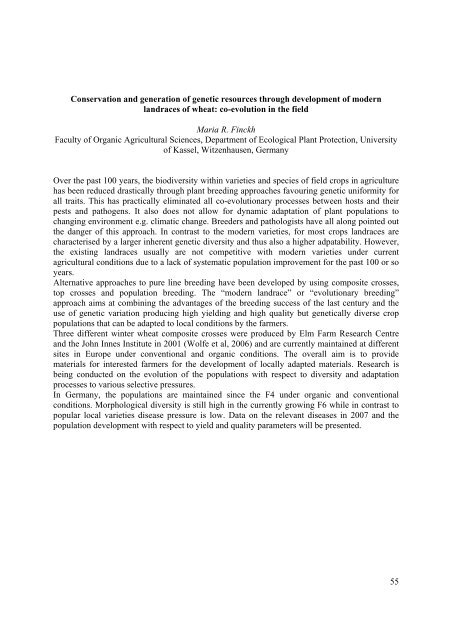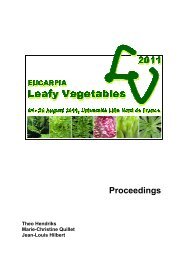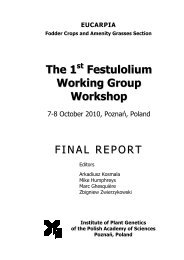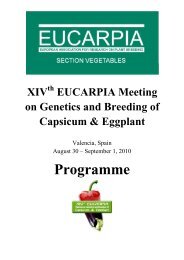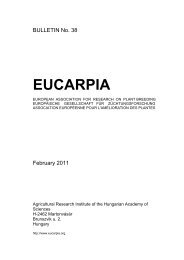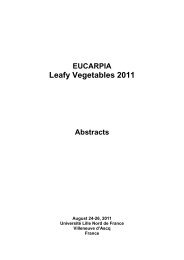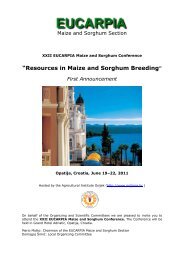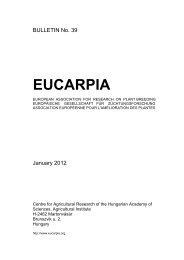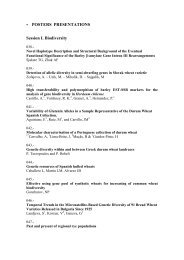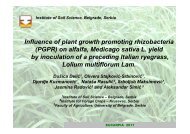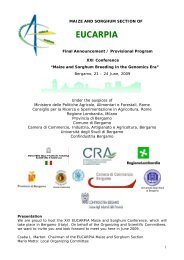Plant breeding for organic and sustainable, low-input agriculture
Plant breeding for organic and sustainable, low-input agriculture
Plant breeding for organic and sustainable, low-input agriculture
You also want an ePaper? Increase the reach of your titles
YUMPU automatically turns print PDFs into web optimized ePapers that Google loves.
Conservation <strong>and</strong> generation of genetic resources through development of modern<br />
l<strong>and</strong>races of wheat: co-evolution in the field<br />
Maria R. Finckh<br />
Faculty of Organic Agricultural Sciences, Department of Ecological <strong>Plant</strong> Protection, University<br />
of Kassel, Witzenhausen, Germany<br />
Over the past 100 years, the biodiversity within varieties <strong>and</strong> species of field crops in <strong>agriculture</strong><br />
has been reduced drastically through plant <strong>breeding</strong> approaches favouring genetic uni<strong>for</strong>mity <strong>for</strong><br />
all traits. This has practically eliminated all co-evolutionary processes between hosts <strong>and</strong> their<br />
pests <strong>and</strong> pathogens. It also does not al<strong>low</strong> <strong>for</strong> dynamic adaptation of plant populations to<br />
changing environment e.g. climatic change. Breeders <strong>and</strong> pathologists have all along pointed out<br />
the danger of this approach. In contrast to the modern varieties, <strong>for</strong> most crops l<strong>and</strong>races are<br />
characterised by a larger inherent genetic diversity <strong>and</strong> thus also a higher adpatability. However,<br />
the existing l<strong>and</strong>races usually are not competitive with modern varieties under current<br />
agricultural conditions due to a lack of systematic population improvement <strong>for</strong> the past 100 or so<br />
years.<br />
Alternative approaches to pure line <strong>breeding</strong> have been developed by using composite crosses,<br />
top crosses <strong>and</strong> population <strong>breeding</strong>. The “modern l<strong>and</strong>race” or “evolutionary <strong>breeding</strong>”<br />
approach aims at combining the advantages of the <strong>breeding</strong> success of the last century <strong>and</strong> the<br />
use of genetic variation producing high yielding <strong>and</strong> high quality but genetically diverse crop<br />
populations that can be adapted to local conditions by the farmers.<br />
Three different winter wheat composite crosses were produced by Elm Farm Research Centre<br />
<strong>and</strong> the John Innes Institute in 2001 (Wolfe et al, 2006) <strong>and</strong> are currently maintained at different<br />
sites in Europe under conventional <strong>and</strong> <strong>organic</strong> conditions. The overall aim is to provide<br />
materials <strong>for</strong> interested farmers <strong>for</strong> the development of locally adapted materials. Research is<br />
being conducted on the evolution of the populations with respect to diversity <strong>and</strong> adaptation<br />
processes to various selective pressures.<br />
In Germany, the populations are maintained since the F4 under <strong>organic</strong> <strong>and</strong> conventional<br />
conditions. Morphological diversity is still high in the currently growing F6 while in contrast to<br />
popular local varieties disease pressure is <strong>low</strong>. Data on the relevant diseases in 2007 <strong>and</strong> the<br />
population development with respect to yield <strong>and</strong> quality parameters will be presented.<br />
55


